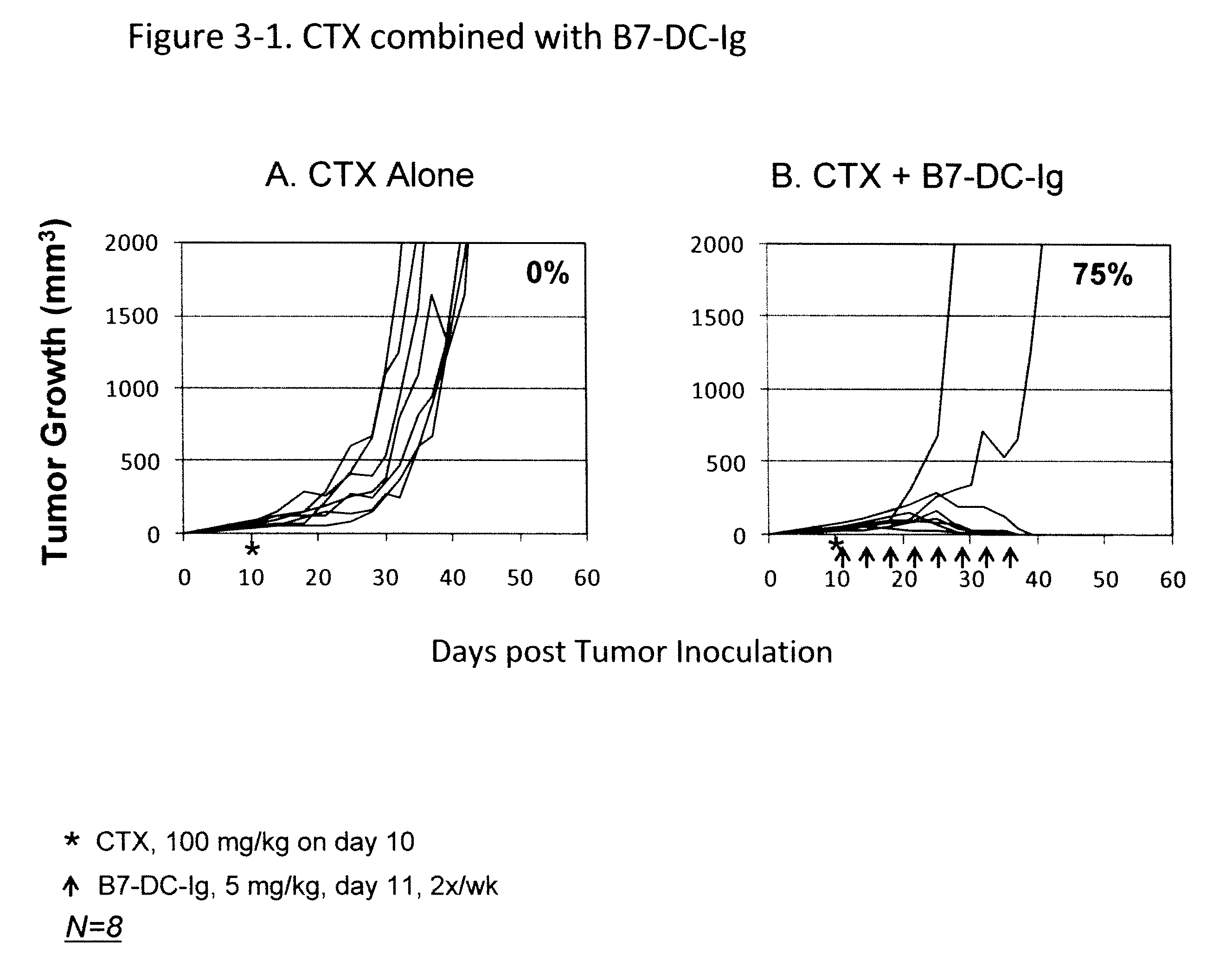Compositions of pd-1 antagonists and methods of use
a technology of pd-1 and antagonists, which is applied in the field of compositions of therapeutic drugs, can solve the problems of complexity, t lymphocyte response to disease states, and reduce inhibitory signal transduction, so as to increase the t cell response of said mammal, reduce the effect of inhibitory signal transduction
- Summary
- Abstract
- Description
- Claims
- Application Information
AI Technical Summary
Benefits of technology
Problems solved by technology
Method used
Image
Examples
example 1
B7-DC-Ig Binds to PD01 Expressing CHO Cells
[0249]B7-DC-Ig was first conjugated with allophycocyanin (APC) and then incubated at various concentrations with a CHO cell line constitutively expressing PD-1 or parent CHO cells that do not express PD-1. Binding was analyzed by flow cytometry. FIG. 1 shows the median fluorescence intensity (MFI) of B7-DC-Ig-APC as a function of the concentration of probe (x-axis). B7-DC-Ig-APC binds to CHO.PD-1 cells (solid circle) but not untransfected CHO cells (gray triangle).
example 2
B7-DC-Ig Competes with B7-H1 for Binding to PD-1
[0250]B7-H1-Ig was first conjugated with allophycocyanin (APC). Unlabeled B7-DC-Ig at various concentrations was first incubated with a CHO cell line constitutively expressing PD-1 before adding B7-H1-Ig-APC to the probe and cell mixture. FIG. 2 shows the median fluorescence intensity (MFI) of B7-H1-Fc-APC is shown as a function of the concentration of unlabeled B7-DC-Ig competitor (x-axis) added. As the concentration of unlabeled B7-DC-Ig is increased the amount of B7-H1-Ig-APC bound to CHO cells decreases, demonstrating that B7-DC-Ig competes with B7-H1 for binding to PD-1.
example 3
CT26 Tumor Model
[0251]Mouse colorectal tumor cell line, CT26, was obtained from ATCC. A master cell bank at Passage 4 was generated following ATCC guidelines. Cells were tested and confirmed no mycoplasma and other pathogen contamination. One vial of tumor cells was thawed from the cryopreserved stocks and grown for two passages prior to inoculation.
[0252]CT26 cells were split at 1:5 dilution with 30 mL complete medium (RPMI+10% FBS, 2 mM L-Glu, and 1× P / S) for two days culture or at 1:10 dilution with 30 ml complete medium for 3 days culture. CT26 cells were harvested by aspirating medium, rinsing the flask with 5 mL PBS, adding 5 mL trypsin, incubating at 37° C. for 2 min, and then neutralizing with 10 mL complete medium. After centrifuge at 600×g (˜1000 rpm) for 5 min, media was sspirateed and the cell pellet was resuspended by pipetting with 10 ml plain RPMI. This wash step was repeated for three times.
[0253]Cell number and viability of the inoculated cells were analyzed by tryp...
PUM
| Property | Measurement | Unit |
|---|---|---|
| Fraction | aaaaa | aaaaa |
| Solubility (mass) | aaaaa | aaaaa |
| Immunogenicity | aaaaa | aaaaa |
Abstract
Description
Claims
Application Information
 Login to View More
Login to View More - R&D
- Intellectual Property
- Life Sciences
- Materials
- Tech Scout
- Unparalleled Data Quality
- Higher Quality Content
- 60% Fewer Hallucinations
Browse by: Latest US Patents, China's latest patents, Technical Efficacy Thesaurus, Application Domain, Technology Topic, Popular Technical Reports.
© 2025 PatSnap. All rights reserved.Legal|Privacy policy|Modern Slavery Act Transparency Statement|Sitemap|About US| Contact US: help@patsnap.com



